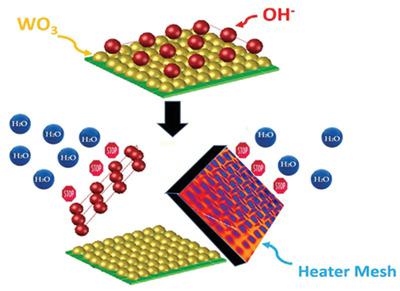当前位置:
X-MOL 学术
›
Cryst. Res. Technol.
›
论文详情
Our official English website, www.x-mol.net, welcomes your
feedback! (Note: you will need to create a separate account there.)
Reduction of Humidity Effect in WO3 Thin Film‐Based NO2 Sensor Using Physiochemical Optimization
Crystal Research and Technology ( IF 1.5 ) Pub Date : 2020-11-27 , DOI: 10.1002/crat.202000155 Sujoy Ghosh 1 , Murugaiya Sridar Ilango 1 , Chandra Shekhar Prajapati 1 , Navakanta Bhat 1
Crystal Research and Technology ( IF 1.5 ) Pub Date : 2020-11-27 , DOI: 10.1002/crat.202000155 Sujoy Ghosh 1 , Murugaiya Sridar Ilango 1 , Chandra Shekhar Prajapati 1 , Navakanta Bhat 1
Affiliation

|
In this work, the effect of humidity on WO3 thin films is studied. Two thin films of higher and lower oxidation states are characterized and studied for their interaction with water molecules on the metal oxide sensing surface. The film with higher oxidation is found to be more immune to humidity effect and hence, further used to reduce the same effect using absorbent filters and Nichrome deposited heater mesh. With the use of a Nichrome heater mesh, by increasing mesh temperature from 30 to 90 °C, there is a 63% reduction in absolute humidity at the sensor die. This in turn stabilizes the NO2 sensor response, by decreasing the humidity dependent (40% RH to 90% RH) peak current variation for 3 ppm NO2 exposure, from 65% to 26%. High‐temperature ageing at a temperature of 90 °C and 90% RH is found to be effective in significantly reducing humidity effect on sensor current output and only 8.4% change in peak current is observed for 3 ppm NO2 at variable humidity, which stabilizes the sensor current drift due to humidity variation.
中文翻译:

通过物理化学优化降低基于WO3薄膜的NO2传感器的湿度影响
在这项工作中,研究了湿度对WO 3薄膜的影响。表征了两种具有较高和较低氧化态的薄膜,并研究了它们与金属氧化物传感表面上水分子的相互作用。发现具有较高氧化性的薄膜更不受湿度影响,因此,使用吸收性过滤器和镍铬合金沉积的加热网可进一步降低相同的效果。使用Nichrome加热器网片时,通过将网片温度从30°C升高到90°C,传感器管芯的绝对湿度降低了63%。反过来,通过降低3 ppm NO 2的湿度相关峰值电流变化(从40%RH到90%RH),稳定了NO 2传感器的响应。曝光率从65%升至26%。发现在90°C和90%RH的温度下进行高温老化可有效降低湿度对传感器电流输出的影响,并且在可变湿度下3 ppm NO 2仅观察到峰值电流的8.4%变化,从而使温度稳定传感器电流因湿度变化而漂移。
更新日期:2021-01-07
中文翻译:

通过物理化学优化降低基于WO3薄膜的NO2传感器的湿度影响
在这项工作中,研究了湿度对WO 3薄膜的影响。表征了两种具有较高和较低氧化态的薄膜,并研究了它们与金属氧化物传感表面上水分子的相互作用。发现具有较高氧化性的薄膜更不受湿度影响,因此,使用吸收性过滤器和镍铬合金沉积的加热网可进一步降低相同的效果。使用Nichrome加热器网片时,通过将网片温度从30°C升高到90°C,传感器管芯的绝对湿度降低了63%。反过来,通过降低3 ppm NO 2的湿度相关峰值电流变化(从40%RH到90%RH),稳定了NO 2传感器的响应。曝光率从65%升至26%。发现在90°C和90%RH的温度下进行高温老化可有效降低湿度对传感器电流输出的影响,并且在可变湿度下3 ppm NO 2仅观察到峰值电流的8.4%变化,从而使温度稳定传感器电流因湿度变化而漂移。











































 京公网安备 11010802027423号
京公网安备 11010802027423号